Comprehensive Analysis of Unilever's Business Environment
VerifiedAdded on 2021/01/01
|14
|3935
|83
Report
AI Summary
This report provides a comprehensive analysis of Unilever's business environment. It begins with an introduction to the concept of the business environment, differentiating between internal and external factors. The report then explores the types, purposes, and legal structures of private, public, and voluntary organizations, using Unilever as a case study for a private entity. It examines the size and scope of different organizations, including Unilever, NHS, and Oxfam. The report delves into the interrelation between various organizational departments within Unilever, such as marketing, finance, HR, and production, and how these departments contribute to achieving business objectives. A significant portion of the report focuses on the impact of macro-environmental factors on Unilever, employing a PESTEL analysis to assess political, economic, social, technological, environmental, and legal influences. The report also conducts an internal analysis of Unilever to identify its strengths and weaknesses, followed by an examination of how macro-environmental factors interact with these internal attributes. The conclusion summarizes the key findings and insights derived from the analysis.
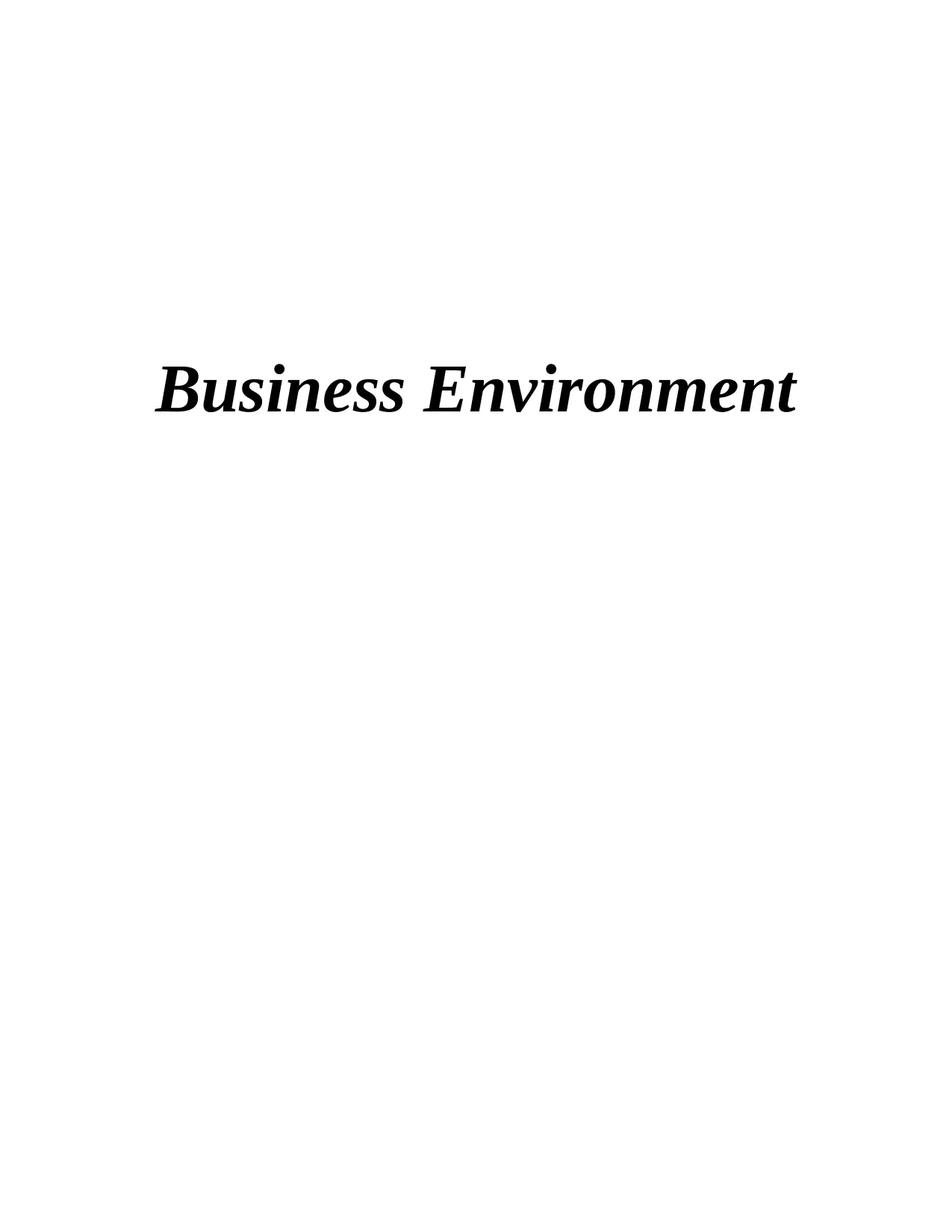
Business Environment
Paraphrase This Document
Need a fresh take? Get an instant paraphrase of this document with our AI Paraphraser
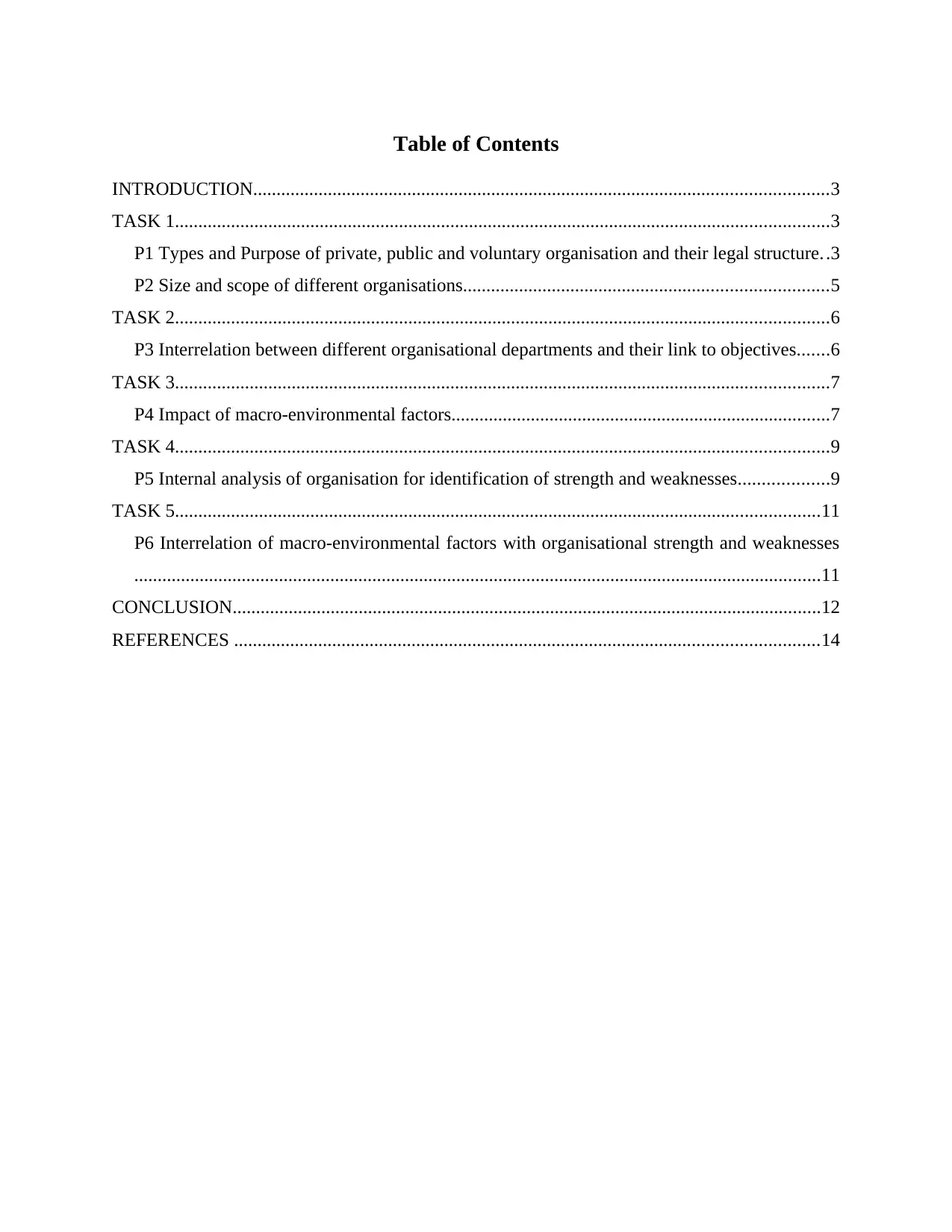
Table of Contents
INTRODUCTION...........................................................................................................................3
TASK 1............................................................................................................................................3
P1 Types and Purpose of private, public and voluntary organisation and their legal structure. .3
P2 Size and scope of different organisations..............................................................................5
TASK 2............................................................................................................................................6
P3 Interrelation between different organisational departments and their link to objectives.......6
TASK 3............................................................................................................................................7
P4 Impact of macro-environmental factors.................................................................................7
TASK 4............................................................................................................................................9
P5 Internal analysis of organisation for identification of strength and weaknesses...................9
TASK 5..........................................................................................................................................11
P6 Interrelation of macro-environmental factors with organisational strength and weaknesses
...................................................................................................................................................11
CONCLUSION..............................................................................................................................12
REFERENCES .............................................................................................................................14
INTRODUCTION...........................................................................................................................3
TASK 1............................................................................................................................................3
P1 Types and Purpose of private, public and voluntary organisation and their legal structure. .3
P2 Size and scope of different organisations..............................................................................5
TASK 2............................................................................................................................................6
P3 Interrelation between different organisational departments and their link to objectives.......6
TASK 3............................................................................................................................................7
P4 Impact of macro-environmental factors.................................................................................7
TASK 4............................................................................................................................................9
P5 Internal analysis of organisation for identification of strength and weaknesses...................9
TASK 5..........................................................................................................................................11
P6 Interrelation of macro-environmental factors with organisational strength and weaknesses
...................................................................................................................................................11
CONCLUSION..............................................................................................................................12
REFERENCES .............................................................................................................................14
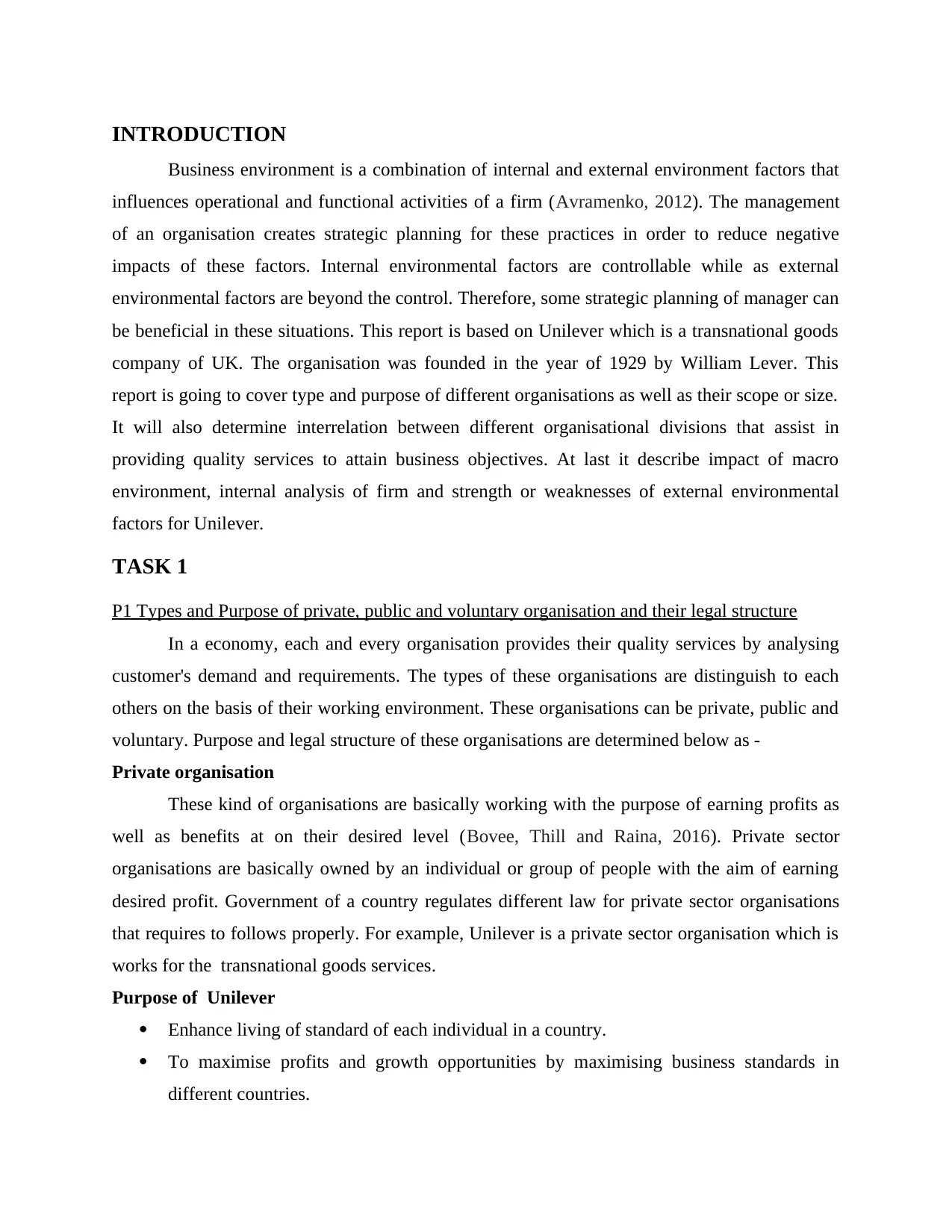
INTRODUCTION
Business environment is a combination of internal and external environment factors that
influences operational and functional activities of a firm (Avramenko, 2012). The management
of an organisation creates strategic planning for these practices in order to reduce negative
impacts of these factors. Internal environmental factors are controllable while as external
environmental factors are beyond the control. Therefore, some strategic planning of manager can
be beneficial in these situations. This report is based on Unilever which is a transnational goods
company of UK. The organisation was founded in the year of 1929 by William Lever. This
report is going to cover type and purpose of different organisations as well as their scope or size.
It will also determine interrelation between different organisational divisions that assist in
providing quality services to attain business objectives. At last it describe impact of macro
environment, internal analysis of firm and strength or weaknesses of external environmental
factors for Unilever.
TASK 1
P1 Types and Purpose of private, public and voluntary organisation and their legal structure
In a economy, each and every organisation provides their quality services by analysing
customer's demand and requirements. The types of these organisations are distinguish to each
others on the basis of their working environment. These organisations can be private, public and
voluntary. Purpose and legal structure of these organisations are determined below as -
Private organisation
These kind of organisations are basically working with the purpose of earning profits as
well as benefits at on their desired level (Bovee, Thill and Raina, 2016). Private sector
organisations are basically owned by an individual or group of people with the aim of earning
desired profit. Government of a country regulates different law for private sector organisations
that requires to follows properly. For example, Unilever is a private sector organisation which is
works for the transnational goods services.
Purpose of Unilever
Enhance living of standard of each individual in a country.
To maximise profits and growth opportunities by maximising business standards in
different countries.
Business environment is a combination of internal and external environment factors that
influences operational and functional activities of a firm (Avramenko, 2012). The management
of an organisation creates strategic planning for these practices in order to reduce negative
impacts of these factors. Internal environmental factors are controllable while as external
environmental factors are beyond the control. Therefore, some strategic planning of manager can
be beneficial in these situations. This report is based on Unilever which is a transnational goods
company of UK. The organisation was founded in the year of 1929 by William Lever. This
report is going to cover type and purpose of different organisations as well as their scope or size.
It will also determine interrelation between different organisational divisions that assist in
providing quality services to attain business objectives. At last it describe impact of macro
environment, internal analysis of firm and strength or weaknesses of external environmental
factors for Unilever.
TASK 1
P1 Types and Purpose of private, public and voluntary organisation and their legal structure
In a economy, each and every organisation provides their quality services by analysing
customer's demand and requirements. The types of these organisations are distinguish to each
others on the basis of their working environment. These organisations can be private, public and
voluntary. Purpose and legal structure of these organisations are determined below as -
Private organisation
These kind of organisations are basically working with the purpose of earning profits as
well as benefits at on their desired level (Bovee, Thill and Raina, 2016). Private sector
organisations are basically owned by an individual or group of people with the aim of earning
desired profit. Government of a country regulates different law for private sector organisations
that requires to follows properly. For example, Unilever is a private sector organisation which is
works for the transnational goods services.
Purpose of Unilever
Enhance living of standard of each individual in a country.
To maximise profits and growth opportunities by maximising business standards in
different countries.
⊘ This is a preview!⊘
Do you want full access?
Subscribe today to unlock all pages.

Trusted by 1+ million students worldwide
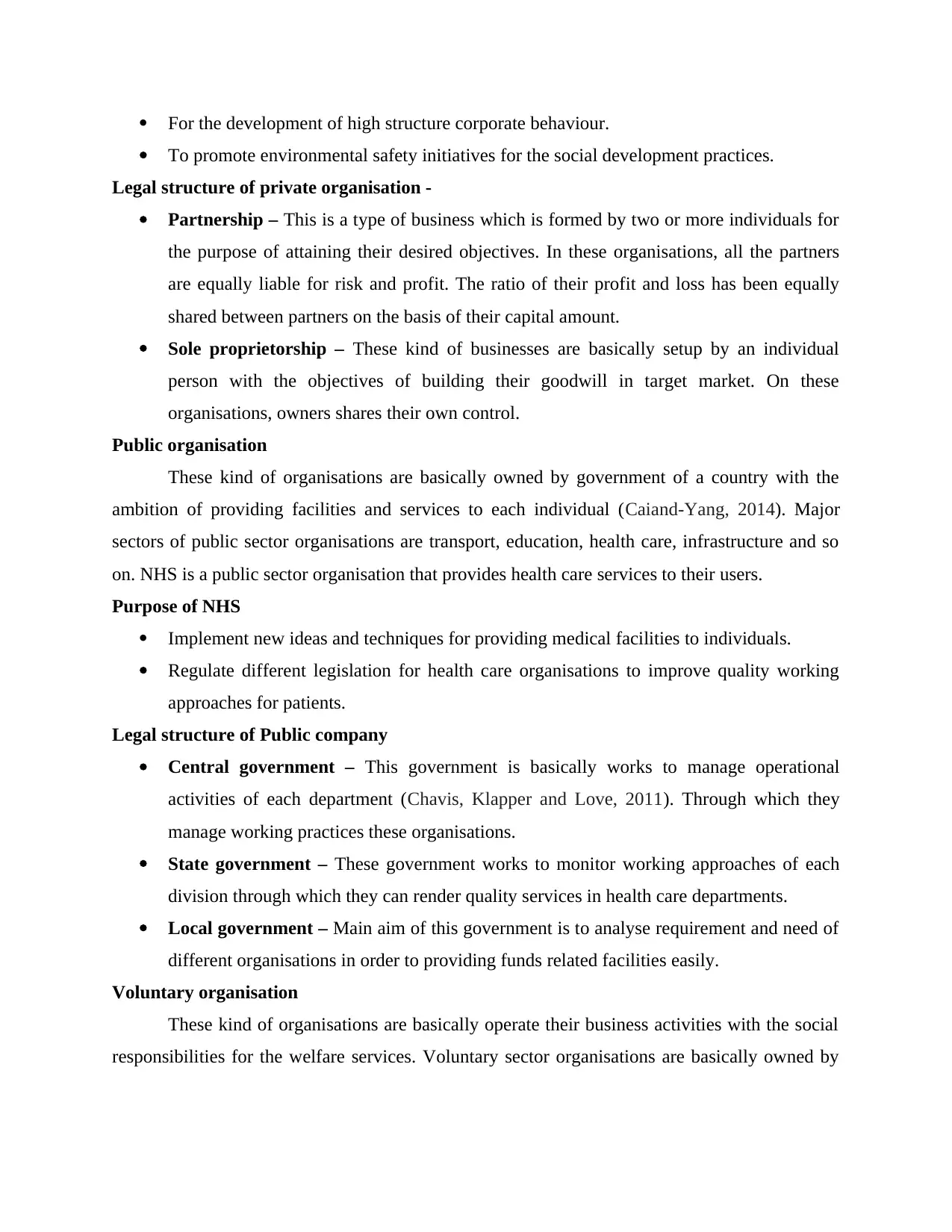
For the development of high structure corporate behaviour.
To promote environmental safety initiatives for the social development practices.
Legal structure of private organisation -
Partnership – This is a type of business which is formed by two or more individuals for
the purpose of attaining their desired objectives. In these organisations, all the partners
are equally liable for risk and profit. The ratio of their profit and loss has been equally
shared between partners on the basis of their capital amount.
Sole proprietorship – These kind of businesses are basically setup by an individual
person with the objectives of building their goodwill in target market. On these
organisations, owners shares their own control.
Public organisation
These kind of organisations are basically owned by government of a country with the
ambition of providing facilities and services to each individual (Caiand-Yang, 2014). Major
sectors of public sector organisations are transport, education, health care, infrastructure and so
on. NHS is a public sector organisation that provides health care services to their users.
Purpose of NHS
Implement new ideas and techniques for providing medical facilities to individuals.
Regulate different legislation for health care organisations to improve quality working
approaches for patients.
Legal structure of Public company
Central government – This government is basically works to manage operational
activities of each department (Chavis, Klapper and Love, 2011). Through which they
manage working practices these organisations.
State government – These government works to monitor working approaches of each
division through which they can render quality services in health care departments.
Local government – Main aim of this government is to analyse requirement and need of
different organisations in order to providing funds related facilities easily.
Voluntary organisation
These kind of organisations are basically operate their business activities with the social
responsibilities for the welfare services. Voluntary sector organisations are basically owned by
To promote environmental safety initiatives for the social development practices.
Legal structure of private organisation -
Partnership – This is a type of business which is formed by two or more individuals for
the purpose of attaining their desired objectives. In these organisations, all the partners
are equally liable for risk and profit. The ratio of their profit and loss has been equally
shared between partners on the basis of their capital amount.
Sole proprietorship – These kind of businesses are basically setup by an individual
person with the objectives of building their goodwill in target market. On these
organisations, owners shares their own control.
Public organisation
These kind of organisations are basically owned by government of a country with the
ambition of providing facilities and services to each individual (Caiand-Yang, 2014). Major
sectors of public sector organisations are transport, education, health care, infrastructure and so
on. NHS is a public sector organisation that provides health care services to their users.
Purpose of NHS
Implement new ideas and techniques for providing medical facilities to individuals.
Regulate different legislation for health care organisations to improve quality working
approaches for patients.
Legal structure of Public company
Central government – This government is basically works to manage operational
activities of each department (Chavis, Klapper and Love, 2011). Through which they
manage working practices these organisations.
State government – These government works to monitor working approaches of each
division through which they can render quality services in health care departments.
Local government – Main aim of this government is to analyse requirement and need of
different organisations in order to providing funds related facilities easily.
Voluntary organisation
These kind of organisations are basically operate their business activities with the social
responsibilities for the welfare services. Voluntary sector organisations are basically owned by
Paraphrase This Document
Need a fresh take? Get an instant paraphrase of this document with our AI Paraphraser
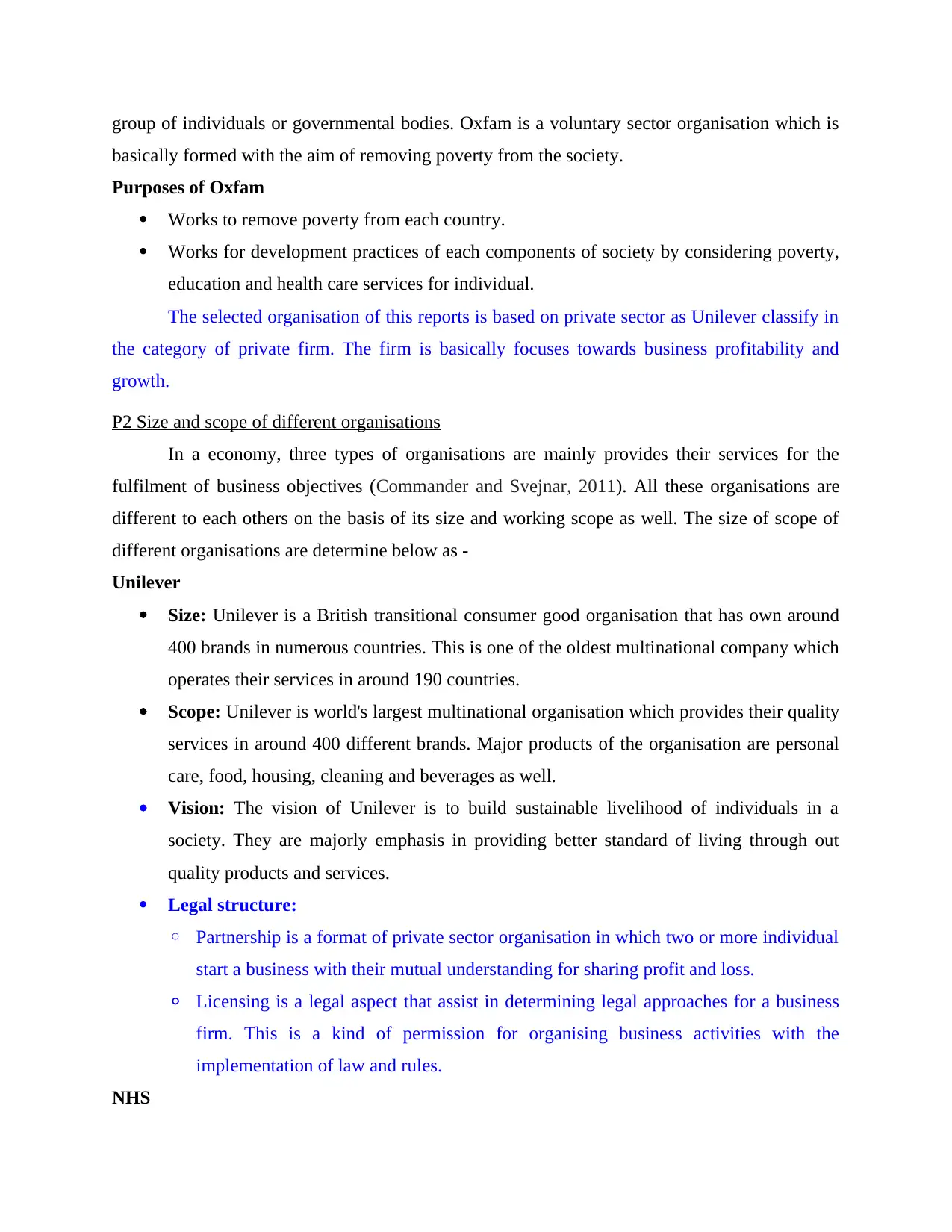
group of individuals or governmental bodies. Oxfam is a voluntary sector organisation which is
basically formed with the aim of removing poverty from the society.
Purposes of Oxfam
Works to remove poverty from each country.
Works for development practices of each components of society by considering poverty,
education and health care services for individual.
The selected organisation of this reports is based on private sector as Unilever classify in
the category of private firm. The firm is basically focuses towards business profitability and
growth.
P2 Size and scope of different organisations
In a economy, three types of organisations are mainly provides their services for the
fulfilment of business objectives (Commander and Svejnar, 2011). All these organisations are
different to each others on the basis of its size and working scope as well. The size of scope of
different organisations are determine below as -
Unilever
Size: Unilever is a British transitional consumer good organisation that has own around
400 brands in numerous countries. This is one of the oldest multinational company which
operates their services in around 190 countries.
Scope: Unilever is world's largest multinational organisation which provides their quality
services in around 400 different brands. Major products of the organisation are personal
care, food, housing, cleaning and beverages as well.
Vision: The vision of Unilever is to build sustainable livelihood of individuals in a
society. They are majorly emphasis in providing better standard of living through out
quality products and services.
Legal structure:
◦ Partnership is a format of private sector organisation in which two or more individual
start a business with their mutual understanding for sharing profit and loss.
◦ Licensing is a legal aspect that assist in determining legal approaches for a business
firm. This is a kind of permission for organising business activities with the
implementation of law and rules.
NHS
basically formed with the aim of removing poverty from the society.
Purposes of Oxfam
Works to remove poverty from each country.
Works for development practices of each components of society by considering poverty,
education and health care services for individual.
The selected organisation of this reports is based on private sector as Unilever classify in
the category of private firm. The firm is basically focuses towards business profitability and
growth.
P2 Size and scope of different organisations
In a economy, three types of organisations are mainly provides their services for the
fulfilment of business objectives (Commander and Svejnar, 2011). All these organisations are
different to each others on the basis of its size and working scope as well. The size of scope of
different organisations are determine below as -
Unilever
Size: Unilever is a British transitional consumer good organisation that has own around
400 brands in numerous countries. This is one of the oldest multinational company which
operates their services in around 190 countries.
Scope: Unilever is world's largest multinational organisation which provides their quality
services in around 400 different brands. Major products of the organisation are personal
care, food, housing, cleaning and beverages as well.
Vision: The vision of Unilever is to build sustainable livelihood of individuals in a
society. They are majorly emphasis in providing better standard of living through out
quality products and services.
Legal structure:
◦ Partnership is a format of private sector organisation in which two or more individual
start a business with their mutual understanding for sharing profit and loss.
◦ Licensing is a legal aspect that assist in determining legal approaches for a business
firm. This is a kind of permission for organising business activities with the
implementation of law and rules.
NHS
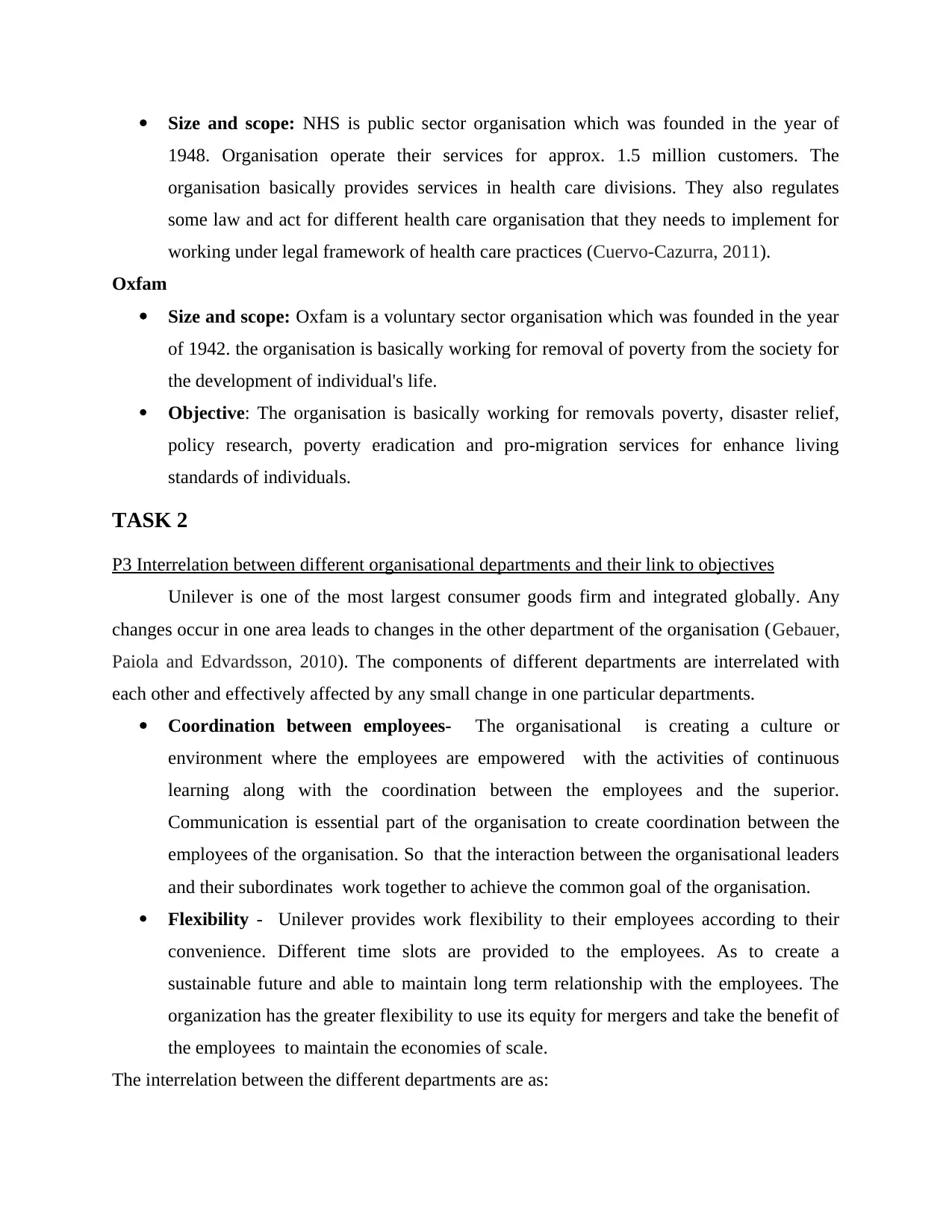
Size and scope: NHS is public sector organisation which was founded in the year of
1948. Organisation operate their services for approx. 1.5 million customers. The
organisation basically provides services in health care divisions. They also regulates
some law and act for different health care organisation that they needs to implement for
working under legal framework of health care practices (Cuervo‐Cazurra, 2011).
Oxfam
Size and scope: Oxfam is a voluntary sector organisation which was founded in the year
of 1942. the organisation is basically working for removal of poverty from the society for
the development of individual's life.
Objective: The organisation is basically working for removals poverty, disaster relief,
policy research, poverty eradication and pro-migration services for enhance living
standards of individuals.
TASK 2
P3 Interrelation between different organisational departments and their link to objectives
Unilever is one of the most largest consumer goods firm and integrated globally. Any
changes occur in one area leads to changes in the other department of the organisation (Gebauer,
Paiola and Edvardsson, 2010). The components of different departments are interrelated with
each other and effectively affected by any small change in one particular departments.
Coordination between employees- The organisational is creating a culture or
environment where the employees are empowered with the activities of continuous
learning along with the coordination between the employees and the superior.
Communication is essential part of the organisation to create coordination between the
employees of the organisation. So that the interaction between the organisational leaders
and their subordinates work together to achieve the common goal of the organisation.
Flexibility - Unilever provides work flexibility to their employees according to their
convenience. Different time slots are provided to the employees. As to create a
sustainable future and able to maintain long term relationship with the employees. The
organization has the greater flexibility to use its equity for mergers and take the benefit of
the employees to maintain the economies of scale.
The interrelation between the different departments are as:
1948. Organisation operate their services for approx. 1.5 million customers. The
organisation basically provides services in health care divisions. They also regulates
some law and act for different health care organisation that they needs to implement for
working under legal framework of health care practices (Cuervo‐Cazurra, 2011).
Oxfam
Size and scope: Oxfam is a voluntary sector organisation which was founded in the year
of 1942. the organisation is basically working for removal of poverty from the society for
the development of individual's life.
Objective: The organisation is basically working for removals poverty, disaster relief,
policy research, poverty eradication and pro-migration services for enhance living
standards of individuals.
TASK 2
P3 Interrelation between different organisational departments and their link to objectives
Unilever is one of the most largest consumer goods firm and integrated globally. Any
changes occur in one area leads to changes in the other department of the organisation (Gebauer,
Paiola and Edvardsson, 2010). The components of different departments are interrelated with
each other and effectively affected by any small change in one particular departments.
Coordination between employees- The organisational is creating a culture or
environment where the employees are empowered with the activities of continuous
learning along with the coordination between the employees and the superior.
Communication is essential part of the organisation to create coordination between the
employees of the organisation. So that the interaction between the organisational leaders
and their subordinates work together to achieve the common goal of the organisation.
Flexibility - Unilever provides work flexibility to their employees according to their
convenience. Different time slots are provided to the employees. As to create a
sustainable future and able to maintain long term relationship with the employees. The
organization has the greater flexibility to use its equity for mergers and take the benefit of
the employees to maintain the economies of scale.
The interrelation between the different departments are as:
⊘ This is a preview!⊘
Do you want full access?
Subscribe today to unlock all pages.

Trusted by 1+ million students worldwide
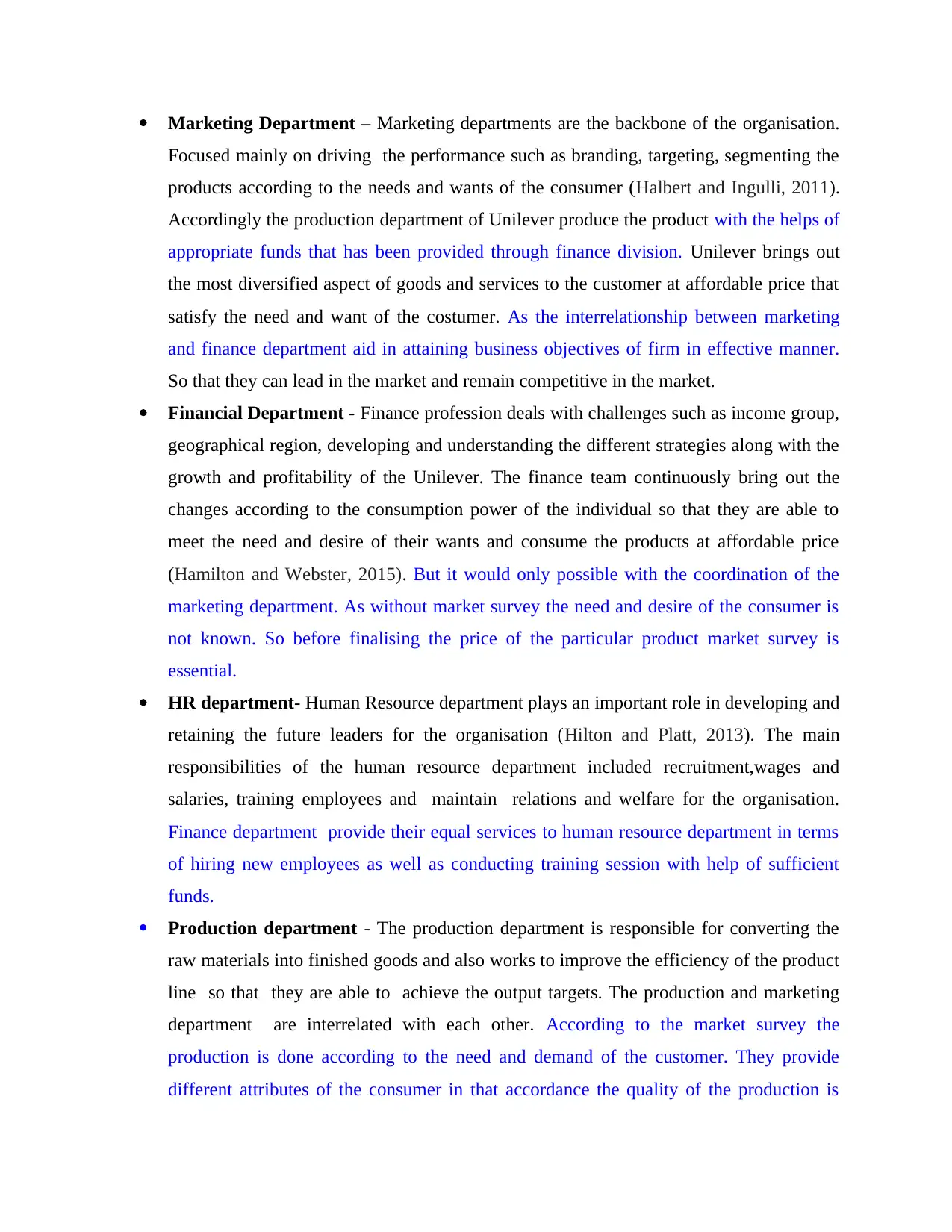
Marketing Department – Marketing departments are the backbone of the organisation.
Focused mainly on driving the performance such as branding, targeting, segmenting the
products according to the needs and wants of the consumer (Halbert and Ingulli, 2011).
Accordingly the production department of Unilever produce the product with the helps of
appropriate funds that has been provided through finance division. Unilever brings out
the most diversified aspect of goods and services to the customer at affordable price that
satisfy the need and want of the costumer. As the interrelationship between marketing
and finance department aid in attaining business objectives of firm in effective manner.
So that they can lead in the market and remain competitive in the market.
Financial Department - Finance profession deals with challenges such as income group,
geographical region, developing and understanding the different strategies along with the
growth and profitability of the Unilever. The finance team continuously bring out the
changes according to the consumption power of the individual so that they are able to
meet the need and desire of their wants and consume the products at affordable price
(Hamilton and Webster, 2015). But it would only possible with the coordination of the
marketing department. As without market survey the need and desire of the consumer is
not known. So before finalising the price of the particular product market survey is
essential.
HR department- Human Resource department plays an important role in developing and
retaining the future leaders for the organisation (Hilton and Platt, 2013). The main
responsibilities of the human resource department included recruitment,wages and
salaries, training employees and maintain relations and welfare for the organisation.
Finance department provide their equal services to human resource department in terms
of hiring new employees as well as conducting training session with help of sufficient
funds.
Production department - The production department is responsible for converting the
raw materials into finished goods and also works to improve the efficiency of the product
line so that they are able to achieve the output targets. The production and marketing
department are interrelated with each other. According to the market survey the
production is done according to the need and demand of the customer. They provide
different attributes of the consumer in that accordance the quality of the production is
Focused mainly on driving the performance such as branding, targeting, segmenting the
products according to the needs and wants of the consumer (Halbert and Ingulli, 2011).
Accordingly the production department of Unilever produce the product with the helps of
appropriate funds that has been provided through finance division. Unilever brings out
the most diversified aspect of goods and services to the customer at affordable price that
satisfy the need and want of the costumer. As the interrelationship between marketing
and finance department aid in attaining business objectives of firm in effective manner.
So that they can lead in the market and remain competitive in the market.
Financial Department - Finance profession deals with challenges such as income group,
geographical region, developing and understanding the different strategies along with the
growth and profitability of the Unilever. The finance team continuously bring out the
changes according to the consumption power of the individual so that they are able to
meet the need and desire of their wants and consume the products at affordable price
(Hamilton and Webster, 2015). But it would only possible with the coordination of the
marketing department. As without market survey the need and desire of the consumer is
not known. So before finalising the price of the particular product market survey is
essential.
HR department- Human Resource department plays an important role in developing and
retaining the future leaders for the organisation (Hilton and Platt, 2013). The main
responsibilities of the human resource department included recruitment,wages and
salaries, training employees and maintain relations and welfare for the organisation.
Finance department provide their equal services to human resource department in terms
of hiring new employees as well as conducting training session with help of sufficient
funds.
Production department - The production department is responsible for converting the
raw materials into finished goods and also works to improve the efficiency of the product
line so that they are able to achieve the output targets. The production and marketing
department are interrelated with each other. According to the market survey the
production is done according to the need and demand of the customer. They provide
different attributes of the consumer in that accordance the quality of the production is
Paraphrase This Document
Need a fresh take? Get an instant paraphrase of this document with our AI Paraphraser
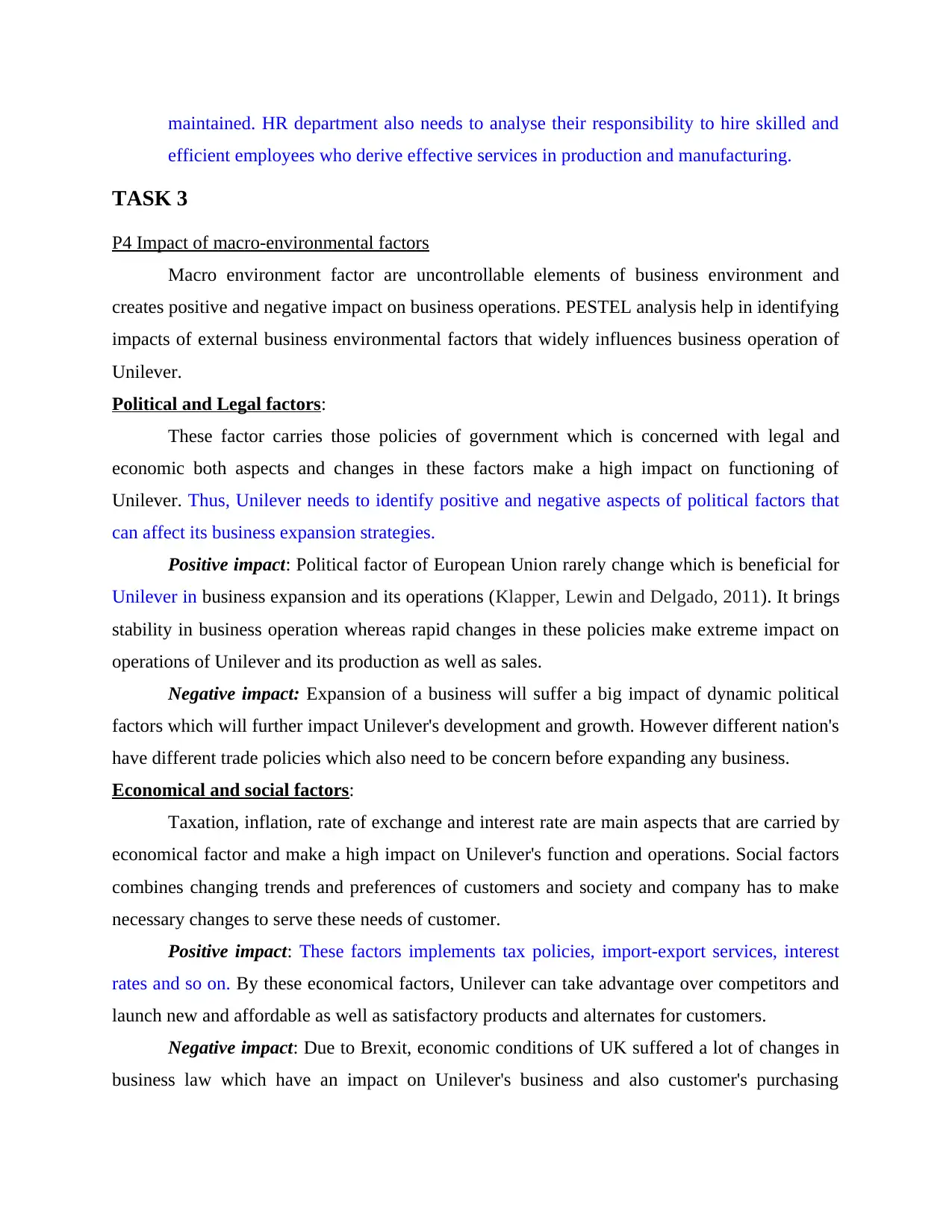
maintained. HR department also needs to analyse their responsibility to hire skilled and
efficient employees who derive effective services in production and manufacturing.
TASK 3
P4 Impact of macro-environmental factors
Macro environment factor are uncontrollable elements of business environment and
creates positive and negative impact on business operations. PESTEL analysis help in identifying
impacts of external business environmental factors that widely influences business operation of
Unilever.
Political and Legal factors:
These factor carries those policies of government which is concerned with legal and
economic both aspects and changes in these factors make a high impact on functioning of
Unilever. Thus, Unilever needs to identify positive and negative aspects of political factors that
can affect its business expansion strategies.
Positive impact: Political factor of European Union rarely change which is beneficial for
Unilever in business expansion and its operations (Klapper, Lewin and Delgado, 2011). It brings
stability in business operation whereas rapid changes in these policies make extreme impact on
operations of Unilever and its production as well as sales.
Negative impact: Expansion of a business will suffer a big impact of dynamic political
factors which will further impact Unilever's development and growth. However different nation's
have different trade policies which also need to be concern before expanding any business.
Economical and social factors:
Taxation, inflation, rate of exchange and interest rate are main aspects that are carried by
economical factor and make a high impact on Unilever's function and operations. Social factors
combines changing trends and preferences of customers and society and company has to make
necessary changes to serve these needs of customer.
Positive impact: These factors implements tax policies, import-export services, interest
rates and so on. By these economical factors, Unilever can take advantage over competitors and
launch new and affordable as well as satisfactory products and alternates for customers.
Negative impact: Due to Brexit, economic conditions of UK suffered a lot of changes in
business law which have an impact on Unilever's business and also customer's purchasing
efficient employees who derive effective services in production and manufacturing.
TASK 3
P4 Impact of macro-environmental factors
Macro environment factor are uncontrollable elements of business environment and
creates positive and negative impact on business operations. PESTEL analysis help in identifying
impacts of external business environmental factors that widely influences business operation of
Unilever.
Political and Legal factors:
These factor carries those policies of government which is concerned with legal and
economic both aspects and changes in these factors make a high impact on functioning of
Unilever. Thus, Unilever needs to identify positive and negative aspects of political factors that
can affect its business expansion strategies.
Positive impact: Political factor of European Union rarely change which is beneficial for
Unilever in business expansion and its operations (Klapper, Lewin and Delgado, 2011). It brings
stability in business operation whereas rapid changes in these policies make extreme impact on
operations of Unilever and its production as well as sales.
Negative impact: Expansion of a business will suffer a big impact of dynamic political
factors which will further impact Unilever's development and growth. However different nation's
have different trade policies which also need to be concern before expanding any business.
Economical and social factors:
Taxation, inflation, rate of exchange and interest rate are main aspects that are carried by
economical factor and make a high impact on Unilever's function and operations. Social factors
combines changing trends and preferences of customers and society and company has to make
necessary changes to serve these needs of customer.
Positive impact: These factors implements tax policies, import-export services, interest
rates and so on. By these economical factors, Unilever can take advantage over competitors and
launch new and affordable as well as satisfactory products and alternates for customers.
Negative impact: Due to Brexit, economic conditions of UK suffered a lot of changes in
business law which have an impact on Unilever's business and also customer's purchasing
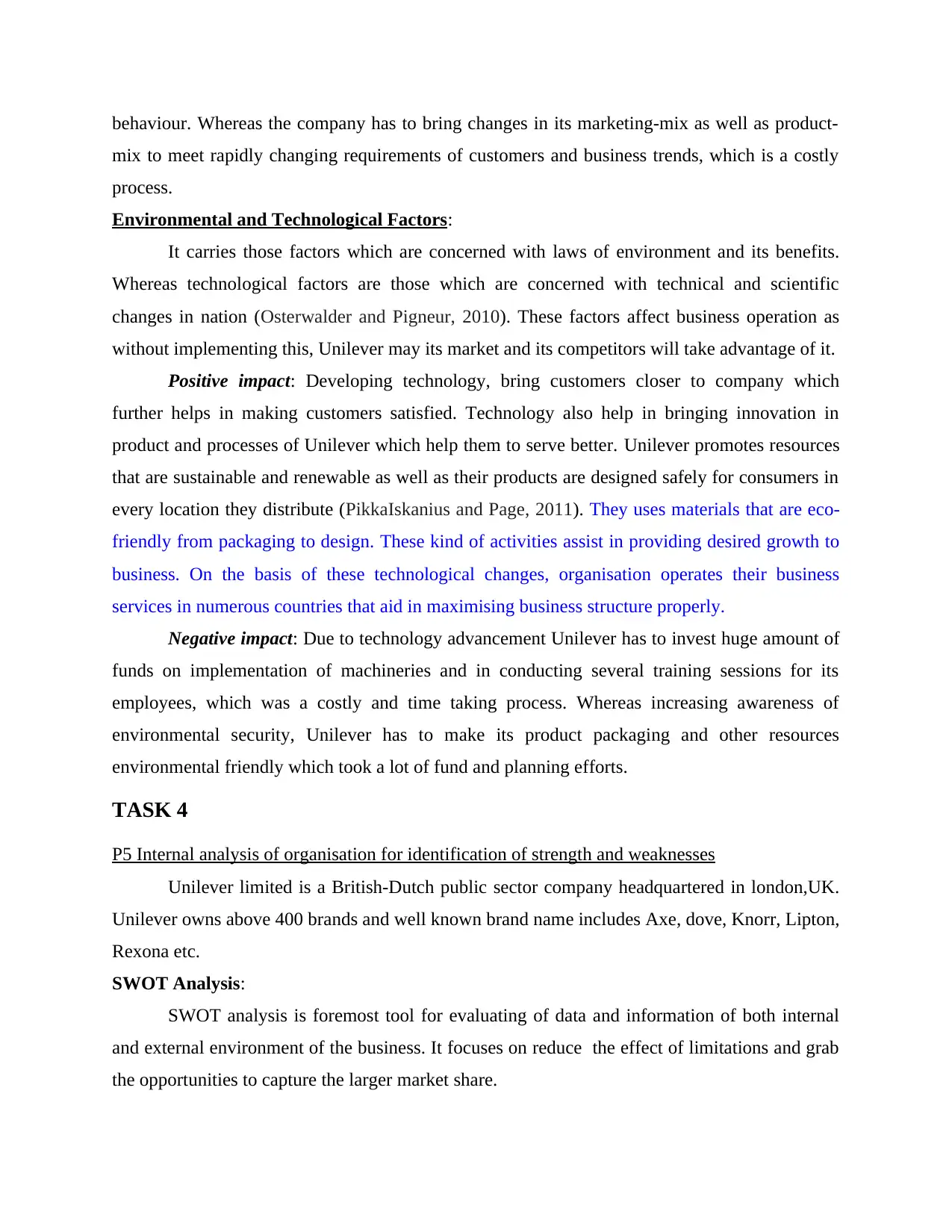
behaviour. Whereas the company has to bring changes in its marketing-mix as well as product-
mix to meet rapidly changing requirements of customers and business trends, which is a costly
process.
Environmental and Technological Factors:
It carries those factors which are concerned with laws of environment and its benefits.
Whereas technological factors are those which are concerned with technical and scientific
changes in nation (Osterwalder and Pigneur, 2010). These factors affect business operation as
without implementing this, Unilever may its market and its competitors will take advantage of it.
Positive impact: Developing technology, bring customers closer to company which
further helps in making customers satisfied. Technology also help in bringing innovation in
product and processes of Unilever which help them to serve better. Unilever promotes resources
that are sustainable and renewable as well as their products are designed safely for consumers in
every location they distribute (PikkaIskanius and Page, 2011). They uses materials that are eco-
friendly from packaging to design. These kind of activities assist in providing desired growth to
business. On the basis of these technological changes, organisation operates their business
services in numerous countries that aid in maximising business structure properly.
Negative impact: Due to technology advancement Unilever has to invest huge amount of
funds on implementation of machineries and in conducting several training sessions for its
employees, which was a costly and time taking process. Whereas increasing awareness of
environmental security, Unilever has to make its product packaging and other resources
environmental friendly which took a lot of fund and planning efforts.
TASK 4
P5 Internal analysis of organisation for identification of strength and weaknesses
Unilever limited is a British-Dutch public sector company headquartered in london,UK.
Unilever owns above 400 brands and well known brand name includes Axe, dove, Knorr, Lipton,
Rexona etc.
SWOT Analysis:
SWOT analysis is foremost tool for evaluating of data and information of both internal
and external environment of the business. It focuses on reduce the effect of limitations and grab
the opportunities to capture the larger market share.
mix to meet rapidly changing requirements of customers and business trends, which is a costly
process.
Environmental and Technological Factors:
It carries those factors which are concerned with laws of environment and its benefits.
Whereas technological factors are those which are concerned with technical and scientific
changes in nation (Osterwalder and Pigneur, 2010). These factors affect business operation as
without implementing this, Unilever may its market and its competitors will take advantage of it.
Positive impact: Developing technology, bring customers closer to company which
further helps in making customers satisfied. Technology also help in bringing innovation in
product and processes of Unilever which help them to serve better. Unilever promotes resources
that are sustainable and renewable as well as their products are designed safely for consumers in
every location they distribute (PikkaIskanius and Page, 2011). They uses materials that are eco-
friendly from packaging to design. These kind of activities assist in providing desired growth to
business. On the basis of these technological changes, organisation operates their business
services in numerous countries that aid in maximising business structure properly.
Negative impact: Due to technology advancement Unilever has to invest huge amount of
funds on implementation of machineries and in conducting several training sessions for its
employees, which was a costly and time taking process. Whereas increasing awareness of
environmental security, Unilever has to make its product packaging and other resources
environmental friendly which took a lot of fund and planning efforts.
TASK 4
P5 Internal analysis of organisation for identification of strength and weaknesses
Unilever limited is a British-Dutch public sector company headquartered in london,UK.
Unilever owns above 400 brands and well known brand name includes Axe, dove, Knorr, Lipton,
Rexona etc.
SWOT Analysis:
SWOT analysis is foremost tool for evaluating of data and information of both internal
and external environment of the business. It focuses on reduce the effect of limitations and grab
the opportunities to capture the larger market share.
⊘ This is a preview!⊘
Do you want full access?
Subscribe today to unlock all pages.

Trusted by 1+ million students worldwide
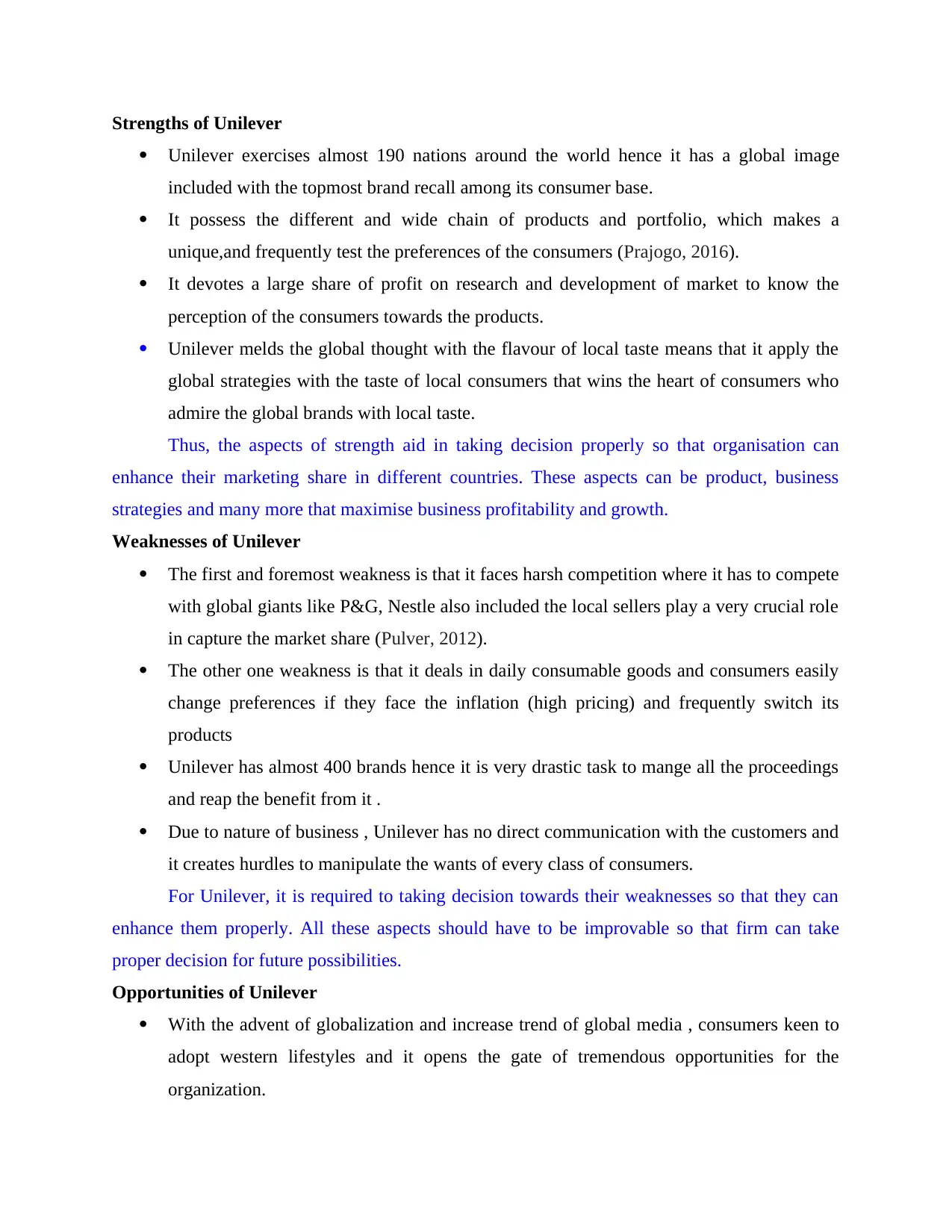
Strengths of Unilever
Unilever exercises almost 190 nations around the world hence it has a global image
included with the topmost brand recall among its consumer base.
It possess the different and wide chain of products and portfolio, which makes a
unique,and frequently test the preferences of the consumers (Prajogo, 2016).
It devotes a large share of profit on research and development of market to know the
perception of the consumers towards the products.
Unilever melds the global thought with the flavour of local taste means that it apply the
global strategies with the taste of local consumers that wins the heart of consumers who
admire the global brands with local taste.
Thus, the aspects of strength aid in taking decision properly so that organisation can
enhance their marketing share in different countries. These aspects can be product, business
strategies and many more that maximise business profitability and growth.
Weaknesses of Unilever
The first and foremost weakness is that it faces harsh competition where it has to compete
with global giants like P&G, Nestle also included the local sellers play a very crucial role
in capture the market share (Pulver, 2012).
The other one weakness is that it deals in daily consumable goods and consumers easily
change preferences if they face the inflation (high pricing) and frequently switch its
products
Unilever has almost 400 brands hence it is very drastic task to mange all the proceedings
and reap the benefit from it .
Due to nature of business , Unilever has no direct communication with the customers and
it creates hurdles to manipulate the wants of every class of consumers.
For Unilever, it is required to taking decision towards their weaknesses so that they can
enhance them properly. All these aspects should have to be improvable so that firm can take
proper decision for future possibilities.
Opportunities of Unilever
With the advent of globalization and increase trend of global media , consumers keen to
adopt western lifestyles and it opens the gate of tremendous opportunities for the
organization.
Unilever exercises almost 190 nations around the world hence it has a global image
included with the topmost brand recall among its consumer base.
It possess the different and wide chain of products and portfolio, which makes a
unique,and frequently test the preferences of the consumers (Prajogo, 2016).
It devotes a large share of profit on research and development of market to know the
perception of the consumers towards the products.
Unilever melds the global thought with the flavour of local taste means that it apply the
global strategies with the taste of local consumers that wins the heart of consumers who
admire the global brands with local taste.
Thus, the aspects of strength aid in taking decision properly so that organisation can
enhance their marketing share in different countries. These aspects can be product, business
strategies and many more that maximise business profitability and growth.
Weaknesses of Unilever
The first and foremost weakness is that it faces harsh competition where it has to compete
with global giants like P&G, Nestle also included the local sellers play a very crucial role
in capture the market share (Pulver, 2012).
The other one weakness is that it deals in daily consumable goods and consumers easily
change preferences if they face the inflation (high pricing) and frequently switch its
products
Unilever has almost 400 brands hence it is very drastic task to mange all the proceedings
and reap the benefit from it .
Due to nature of business , Unilever has no direct communication with the customers and
it creates hurdles to manipulate the wants of every class of consumers.
For Unilever, it is required to taking decision towards their weaknesses so that they can
enhance them properly. All these aspects should have to be improvable so that firm can take
proper decision for future possibilities.
Opportunities of Unilever
With the advent of globalization and increase trend of global media , consumers keen to
adopt western lifestyles and it opens the gate of tremendous opportunities for the
organization.
Paraphrase This Document
Need a fresh take? Get an instant paraphrase of this document with our AI Paraphraser
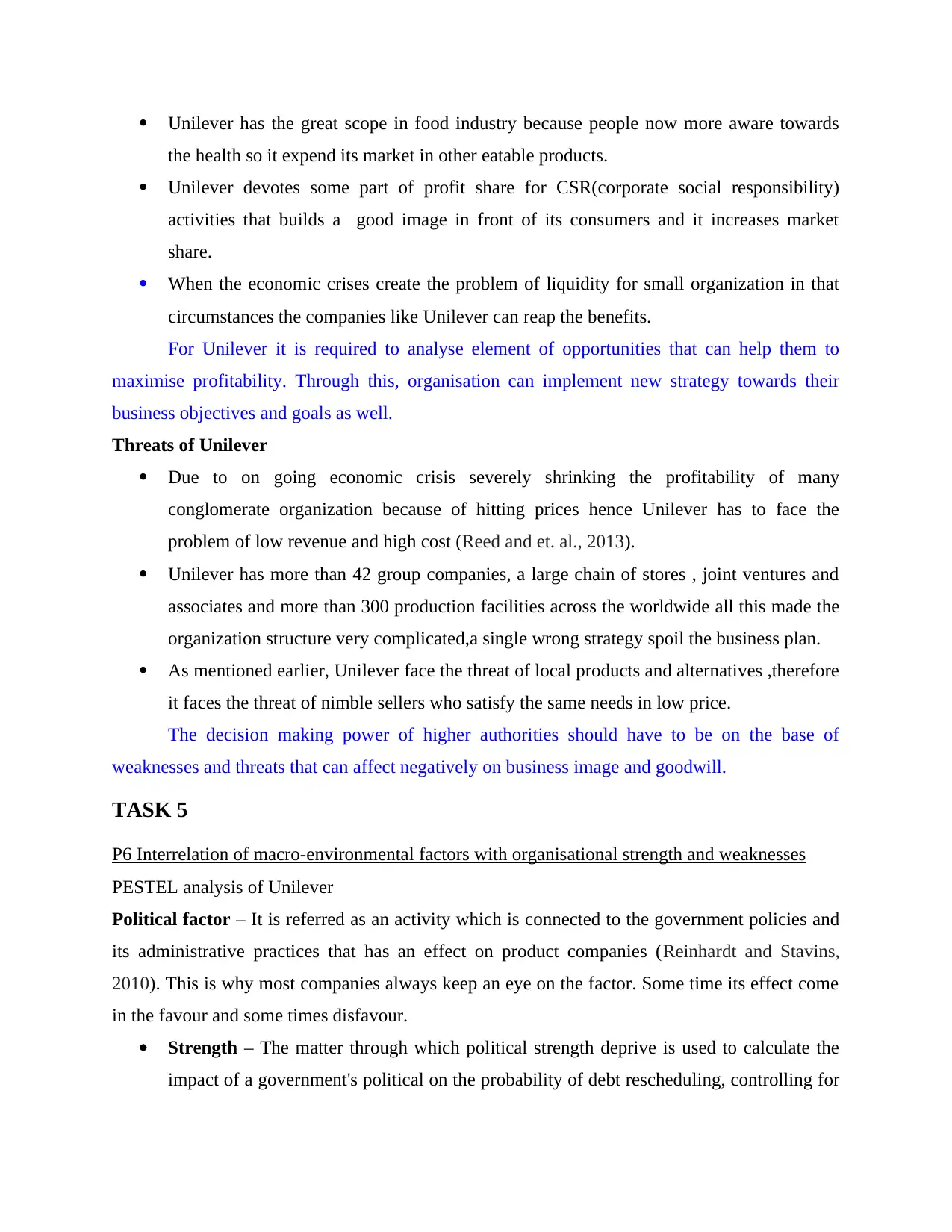
Unilever has the great scope in food industry because people now more aware towards
the health so it expend its market in other eatable products.
Unilever devotes some part of profit share for CSR(corporate social responsibility)
activities that builds a good image in front of its consumers and it increases market
share.
When the economic crises create the problem of liquidity for small organization in that
circumstances the companies like Unilever can reap the benefits.
For Unilever it is required to analyse element of opportunities that can help them to
maximise profitability. Through this, organisation can implement new strategy towards their
business objectives and goals as well.
Threats of Unilever
Due to on going economic crisis severely shrinking the profitability of many
conglomerate organization because of hitting prices hence Unilever has to face the
problem of low revenue and high cost (Reed and et. al., 2013).
Unilever has more than 42 group companies, a large chain of stores , joint ventures and
associates and more than 300 production facilities across the worldwide all this made the
organization structure very complicated,a single wrong strategy spoil the business plan.
As mentioned earlier, Unilever face the threat of local products and alternatives ,therefore
it faces the threat of nimble sellers who satisfy the same needs in low price.
The decision making power of higher authorities should have to be on the base of
weaknesses and threats that can affect negatively on business image and goodwill.
TASK 5
P6 Interrelation of macro-environmental factors with organisational strength and weaknesses
PESTEL analysis of Unilever
Political factor – It is referred as an activity which is connected to the government policies and
its administrative practices that has an effect on product companies (Reinhardt and Stavins,
2010). This is why most companies always keep an eye on the factor. Some time its effect come
in the favour and some times disfavour.
Strength – The matter through which political strength deprive is used to calculate the
impact of a government's political on the probability of debt rescheduling, controlling for
the health so it expend its market in other eatable products.
Unilever devotes some part of profit share for CSR(corporate social responsibility)
activities that builds a good image in front of its consumers and it increases market
share.
When the economic crises create the problem of liquidity for small organization in that
circumstances the companies like Unilever can reap the benefits.
For Unilever it is required to analyse element of opportunities that can help them to
maximise profitability. Through this, organisation can implement new strategy towards their
business objectives and goals as well.
Threats of Unilever
Due to on going economic crisis severely shrinking the profitability of many
conglomerate organization because of hitting prices hence Unilever has to face the
problem of low revenue and high cost (Reed and et. al., 2013).
Unilever has more than 42 group companies, a large chain of stores , joint ventures and
associates and more than 300 production facilities across the worldwide all this made the
organization structure very complicated,a single wrong strategy spoil the business plan.
As mentioned earlier, Unilever face the threat of local products and alternatives ,therefore
it faces the threat of nimble sellers who satisfy the same needs in low price.
The decision making power of higher authorities should have to be on the base of
weaknesses and threats that can affect negatively on business image and goodwill.
TASK 5
P6 Interrelation of macro-environmental factors with organisational strength and weaknesses
PESTEL analysis of Unilever
Political factor – It is referred as an activity which is connected to the government policies and
its administrative practices that has an effect on product companies (Reinhardt and Stavins,
2010). This is why most companies always keep an eye on the factor. Some time its effect come
in the favour and some times disfavour.
Strength – The matter through which political strength deprive is used to calculate the
impact of a government's political on the probability of debt rescheduling, controlling for
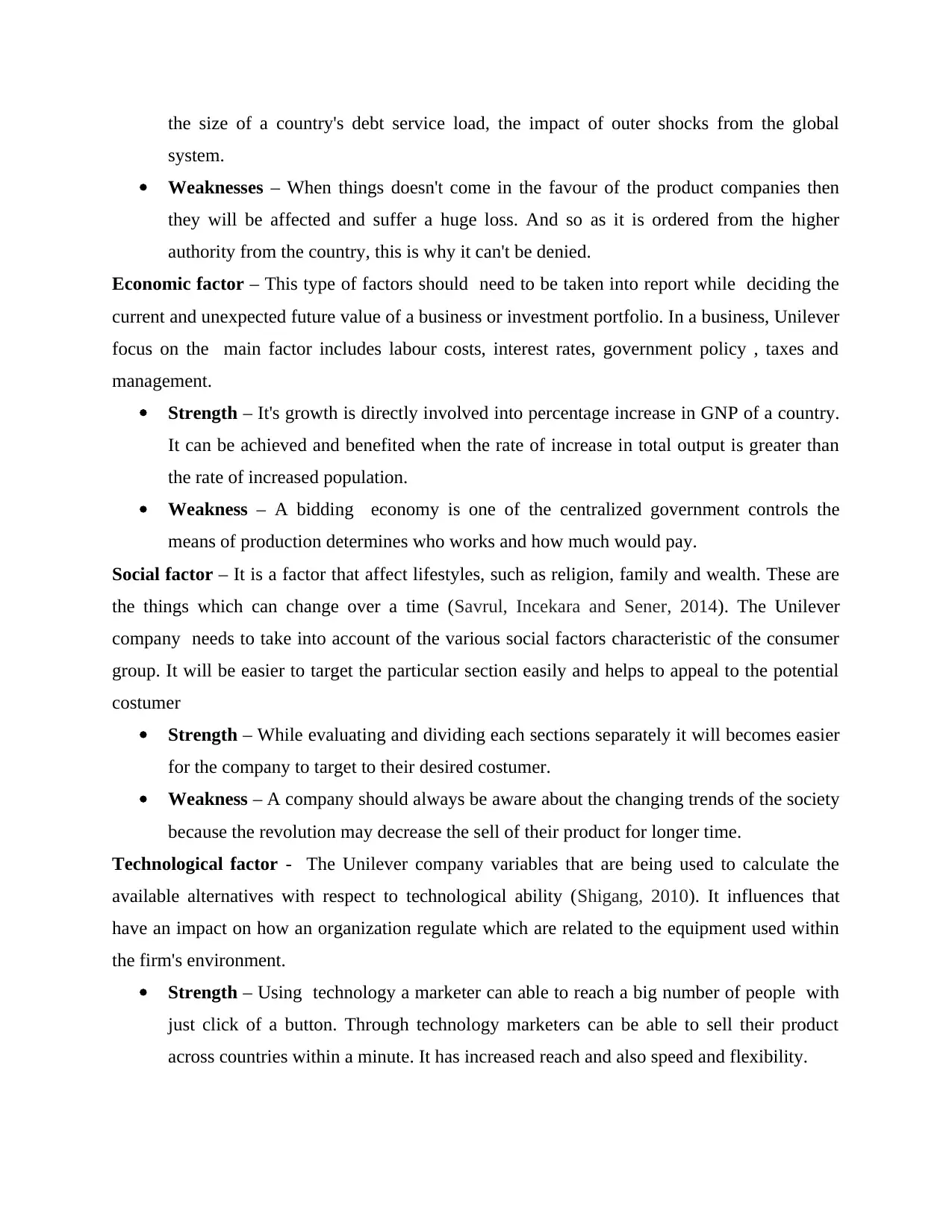
the size of a country's debt service load, the impact of outer shocks from the global
system.
Weaknesses – When things doesn't come in the favour of the product companies then
they will be affected and suffer a huge loss. And so as it is ordered from the higher
authority from the country, this is why it can't be denied.
Economic factor – This type of factors should need to be taken into report while deciding the
current and unexpected future value of a business or investment portfolio. In a business, Unilever
focus on the main factor includes labour costs, interest rates, government policy , taxes and
management.
Strength – It's growth is directly involved into percentage increase in GNP of a country.
It can be achieved and benefited when the rate of increase in total output is greater than
the rate of increased population.
Weakness – A bidding economy is one of the centralized government controls the
means of production determines who works and how much would pay.
Social factor – It is a factor that affect lifestyles, such as religion, family and wealth. These are
the things which can change over a time (Savrul, Incekara and Sener, 2014). The Unilever
company needs to take into account of the various social factors characteristic of the consumer
group. It will be easier to target the particular section easily and helps to appeal to the potential
costumer
Strength – While evaluating and dividing each sections separately it will becomes easier
for the company to target to their desired costumer.
Weakness – A company should always be aware about the changing trends of the society
because the revolution may decrease the sell of their product for longer time.
Technological factor - The Unilever company variables that are being used to calculate the
available alternatives with respect to technological ability (Shigang, 2010). It influences that
have an impact on how an organization regulate which are related to the equipment used within
the firm's environment.
Strength – Using technology a marketer can able to reach a big number of people with
just click of a button. Through technology marketers can be able to sell their product
across countries within a minute. It has increased reach and also speed and flexibility.
system.
Weaknesses – When things doesn't come in the favour of the product companies then
they will be affected and suffer a huge loss. And so as it is ordered from the higher
authority from the country, this is why it can't be denied.
Economic factor – This type of factors should need to be taken into report while deciding the
current and unexpected future value of a business or investment portfolio. In a business, Unilever
focus on the main factor includes labour costs, interest rates, government policy , taxes and
management.
Strength – It's growth is directly involved into percentage increase in GNP of a country.
It can be achieved and benefited when the rate of increase in total output is greater than
the rate of increased population.
Weakness – A bidding economy is one of the centralized government controls the
means of production determines who works and how much would pay.
Social factor – It is a factor that affect lifestyles, such as religion, family and wealth. These are
the things which can change over a time (Savrul, Incekara and Sener, 2014). The Unilever
company needs to take into account of the various social factors characteristic of the consumer
group. It will be easier to target the particular section easily and helps to appeal to the potential
costumer
Strength – While evaluating and dividing each sections separately it will becomes easier
for the company to target to their desired costumer.
Weakness – A company should always be aware about the changing trends of the society
because the revolution may decrease the sell of their product for longer time.
Technological factor - The Unilever company variables that are being used to calculate the
available alternatives with respect to technological ability (Shigang, 2010). It influences that
have an impact on how an organization regulate which are related to the equipment used within
the firm's environment.
Strength – Using technology a marketer can able to reach a big number of people with
just click of a button. Through technology marketers can be able to sell their product
across countries within a minute. It has increased reach and also speed and flexibility.
⊘ This is a preview!⊘
Do you want full access?
Subscribe today to unlock all pages.

Trusted by 1+ million students worldwide
1 out of 14
Related Documents
Your All-in-One AI-Powered Toolkit for Academic Success.
+13062052269
info@desklib.com
Available 24*7 on WhatsApp / Email
![[object Object]](/_next/static/media/star-bottom.7253800d.svg)
Unlock your academic potential
Copyright © 2020–2025 A2Z Services. All Rights Reserved. Developed and managed by ZUCOL.




